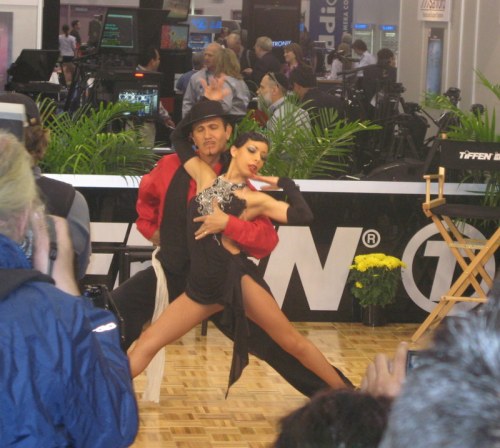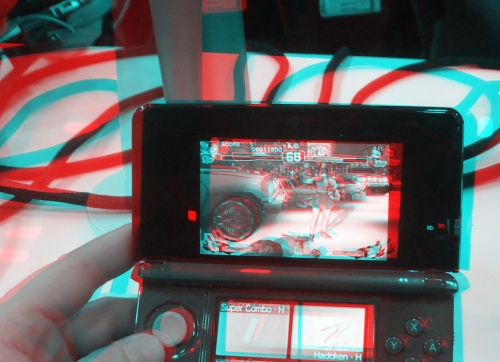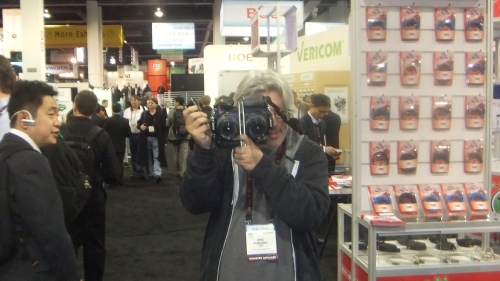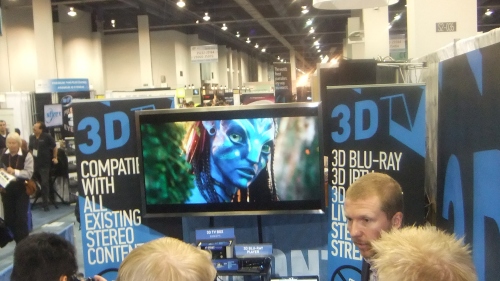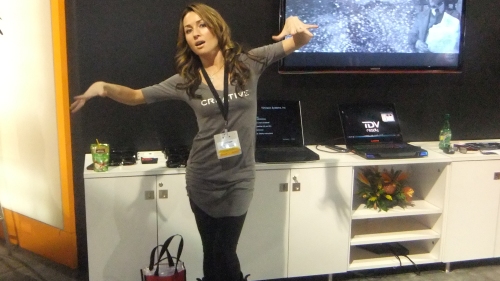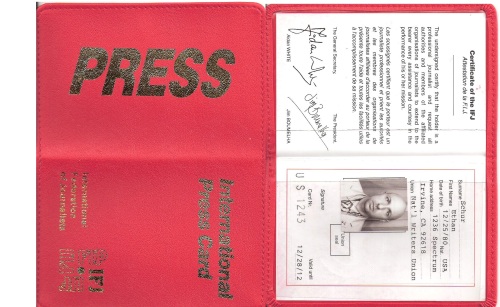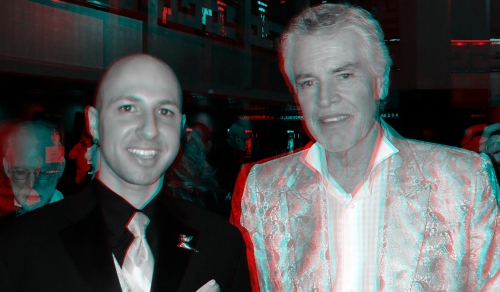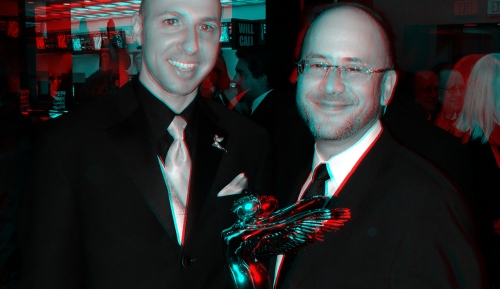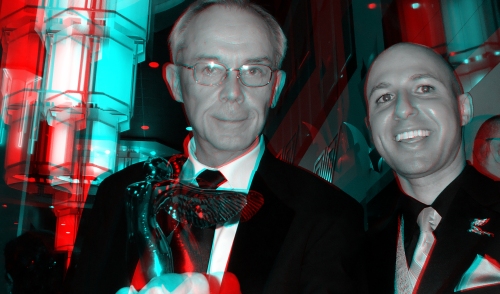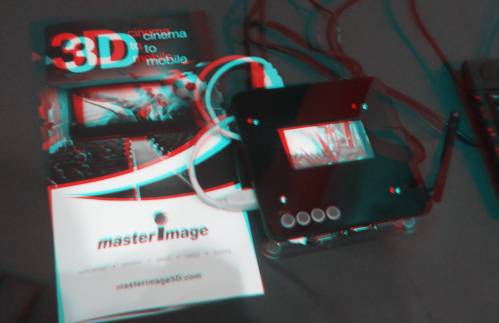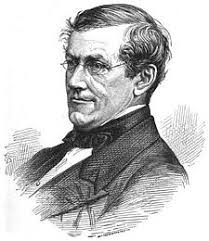Some may say that at 4:41 AM it is technically day 3, but let’s say that CES “days” start when the show opens at 9AM. It’s really cool to see the people that I see all the time tightly suited up and very serious, completely let loose and enjoy their time in Las Vegas after hours. S3D people know how to party!
CES Day two started out with a major catastrophe. One of our XpanD universal loaner glasses had gone missing, clearly this was a case of theft, or alternatively, an absent minded person getting a cellphone call while viewing the content, placing the glasses on their forehead during the call and wandering off, forgetting they were wearing them. I’ll give this absent minded person the benefit of the doubt regarding the possible cause of the disappearance.
I do also except that it is very difficult for our professional spokeswoman to keep her two eyes on ten pairs of glasses for ten hours straight. We devised to make a sign reminding people not to take the glasses. Below you will see Kara, one pair of glasses short, and looking sorry and ashamed.

The ultimate responsibility for the lost pair of XpanD glasses lies with me. It is up to me to break the news to Maria Costeira, CEO of XpanD. Here is Maria, pictured below with TDVision Systems CEO, Manuel Gutierrez Novelo, before I gather my strength to break the devastating news to her.

In order to remedy things, I make a solemn promise that before the week is done, I will change my LinkedIn profile picture from one of me, (from 2007 with more hair) wearing passive glasses, to an all new picture of me at the show wearing the new XpanD YOUNIVERSAL glasses AKA, “my own personalized, capitalized, no-compromise 3D specs”.
I got a chance to finally walk the central hall later in the day. My first visit was to Intel, to chat with their resident futurists, and view their 3D offerings. I must say what is available at this time only barely scratches the surface of what powerful Intel processors can achieve for the stereoscopic eco-system from capture, encoding, transmission and display. That’s why I’m glad Intel employs minority-report type technology “precogs” that are readying for an exponential increase in S3D workflow efficiency.

My next visit was to the Mitsubishi exhibit, I was so happy to encounter the 92″ 3D DLP television. Oh yes it is quite large. I’m quite far back when taking this picture with my arm fully extended vertically.

My goodness, look at the LG Display! It is massive, and it has all sorts of Displays, LED, OLED, Projector, Monitor, Laptop, running passive 3D, just pop on your glasses on everywhere you care to look you see 3D, I can sit close to one display, and perceive 3D images that seem to have a less powerful, depth effect, yet look more rounded and realistic, and simply glance down the hall to another display far away to perceive 3D images that seem to have a strong, elongated depth effect.

I was quite concerned about a serious human factor issue that struck me unexpectedly. A very curious condition appeared in my two eyes that, while only lasting a maximum of five minutes, led to around 2 hours of hypochondria, nervousness, and obsessive googling on my cellphone. In the picture below, taken by concerned citizen and maverick CEO Gina Tanner of Digital Revolution Studios, shows the tail end of one of my pupils being much more dilated than the other.
 At this point I am very much regretting all the bragging I had done last Tuesday, showing off the fusional ability of my supple eyes by creating absurdly enormous parallax values both negative and positive of an anaglyph image, smiling and laughing as I retained stereopsis as the stereopair gradually separated far beyond the “Do no Harm” red-line.
At this point I am very much regretting all the bragging I had done last Tuesday, showing off the fusional ability of my supple eyes by creating absurdly enormous parallax values both negative and positive of an anaglyph image, smiling and laughing as I retained stereopsis as the stereopair gradually separated far beyond the “Do no Harm” red-line.
Strange since I hadn’t worn pulfrich glasses, or in any way occluded one eye, or inhibited the light intake of one vs. the other.
I immediately entered self diagnostic mode. Visual Acuity: Check. Vergence function across several randomly selected horoptic areas: Fully operational. I suppose I shall consult an ophthalmologist when I return. Even though the issue seemed to have cleared after five minutes, I certainly appeared the strange fellow as I earnestly asked a woman handing out tote-bags, “excuse me, would you mind informing me if one of my pupils seems to be larger than the other? No you say? Oh thank you, I’m not partial to that bag but please enjoy the rest of the show”
I looked up from my frantic ocular googling, and found my self in the immense area that was the Panasonic showcase. A large pharaoh like Avatar figure dominated the landscape, spear in hand, the creature’s strangely familiar, unevenly dilated pupils, inspiring fear and awe in all those who dared to approach it to view 3D out of it’s myriad shutter-glasses tipped tentacles.

Respectfully taking my leave of the powerful effigy, I returned to the Toshiba exhibit mentioned in the Day Zero and Day One this time determined to see the glasses free displays, without waiting in the very long and very slow line that wound its way around the exhibit.
I approached the rear-exit of the exhibit. Producing my press credentials , and adopting a very professional and no-nonsense journalistic facade, I implemented my entitlement-related declarations, which prompted the guard to deferentially lift the red barrier rope and usher me inside without delay.
Once inside I realized there were more lines, these lines were to view the laptop displays which use eye tracking to initialize what seemed to be an LCD based parallax barrier. I became increasingly frustrated as the people in front of me asked increasingly silly questions. Finally it was my turn! I must say, the small laptop wasn’t my cup of tea, in fact I really wasn’t able to appreciate any amount of depth. With people behind me, I realized that maybe the people before me weren’t asking silly questions and maybe this device simply isn’t working properly at this time. I decided to move on and take a look at the actual autostereo displays.
Around the corner the large displays were there, rumored to be of 8k resolution and coming in 56″ and 65″ inch, I made sure to stand on the yellow shoe imprint markings on the floor to observe from the correct angle. I’m not sure how many views this display has, I’ve heard 2 and I’ve heard 4. In any case, clearly this is the best NG3D (No Glasses 3D) display I have seen so far. However, these displays still exhibit shifts when traversing viewing zones and artifacts when in between them.
Unlike high quality and real-time 2D to 3D conversion, I believe it may be possible to have auto-stereoscopic displays that are ready for prime time in the home before I own a flying car. Nevertheless, I’m going to err on the side of unexpected innovation and cut my estimated time frame for large NG3D televisions in the home from 20 to 10 years.
This being the case, I’ll hope that companies can be responsible when speaking of NG3D displays in the home, lest consumers say “I’m going to hold off on buying that Full HD 3D television set because company X promises no glasses 3D right around the corner” Weren’t panoramagrams right around the corner at the close of the 19 century?
Below see a picture of the display. I’m actually taking all of the pictures with my Fuji W3 camera, graciously loaned to me by Fuji, however I haven’t figured out how to post MPO formatted files so I’ve been using the 2D jpegs and anaglyph for this website. If you happen to have any anaglyph glasses, (I like anachrome) you can see this S3D pic that I took of the Toshiba NG3D display. Well that’s kind of neat, if I don’t have to wear glasses when imaging 3D then my camera doesn’t need to either! (Sorry about the large reflection on the display, I haven’t mastered my Fuji W3 settings just yet)
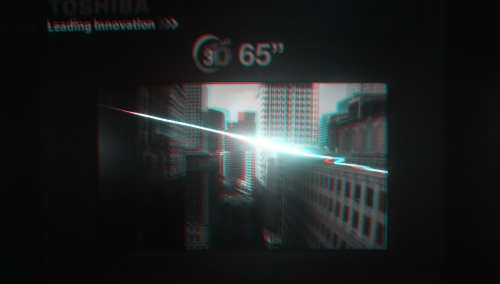

I’m not one who eschews glasses. The opposite! I am in favor of MORE stuff mounted on the face. That’s why I had to check out the latest 1280×1024 OLED revision prototype of the Vusix eyewear, clearly a prototype, this SXGA unit didn’t have the sleek housing of the low-rez models, and the optics showed noticeable warping around the edges of the frame.
The Vusix folks remembered me and TDVision from our work on the groundbreaking TDVisor HMD, and to this day I have not experienced it’s equal in pixel density, brightness, clarity, and effect.

Wrapping up my tour of the show floor I will post below a self-explanatory image:

At TDVision, one thing we really enjoy at the large tradeshows like CES and NAB, is turning our exhibit into a geek friendly, S3D lounge after hours.
Here is TDVision CEO Manuel R. Gutierrez Novelo, with a stereoscopic pioneer and brain-trust Michael Starks of 3DTV Corp, using his stereo-geometrical expertise to help us out in inspecting a certain content real that for some reason I can’t place seems to pinch my brain in a funny way.

Finally we have as our guest the author and stereoscopic expert Bernard Mendiburu, of Volfoni with Bob Johnston, who was featured in the Day 1 post, and is the international director of the 3D Film Festival of which I am happy to sit on the board.

Wow, look at that, it’s almost seven. I’d better get an hour of sleep, my eyes need rest if they are going to remain stereo-acute and dilation matched!
–Ethan Daniel Schur

